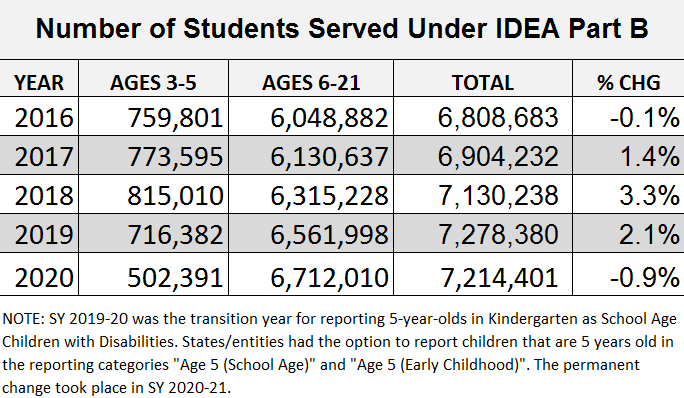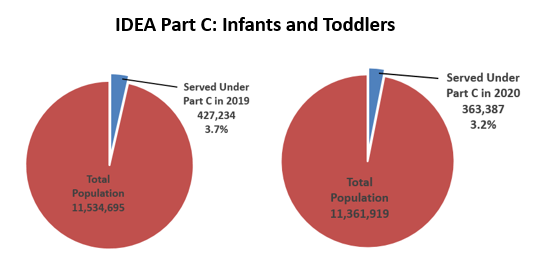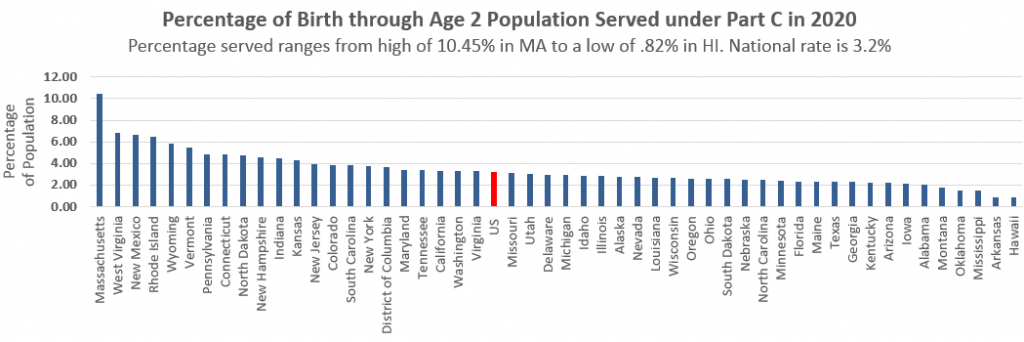New Data: Number of IDEA eligible Students Ages 3-21 in 2020 Shows Little Change From 2019. Number of Infants and Toddlers Drops Significantly.
The U.S. Dept. of Education has released new data on students with disabilities (eligible under the Individuals with Disabilities Education Act or IDEA). Section 618 of the Individuals with Disabilities Education Act (IDEA) requires that each state annually submit data about the infants and toddlers, birth through age 2, who receive early intervention services under Part C of IDEA, and children with disabilities, ages 3 through 21, who receive special education and related services under Part B of IDEA.
The new data – the first since start of the COVID-19 pandemic – shows the number of eligible children in 2020 remained essentially the same as in 2019, ending a steady stream of significant increases over prior years.

Because of a change in the way schools are to report children with disabilities who are 5 years old, the number of students in the 3-5 age range has declined and the number of “school age students” (formerly students ages 6-21) has increased. Beginning in 2020, schools were required to report 5 year olds in kindergarten as School Age Students with Disabilities. The chart below shows the impact of this change.

The percent of the population served continues to vary significantly across states, ranging from a high of 12.98% in Maine to a low of 6.56% in Hawaii

CHANGES IN DISABILITY CATEGORIES
The distribution across disability categories of School Age Students with Disabilities in 2020 remained largely unchanged, with a slight increase in the number of children in the Developmental Delay category which is frequently assigned to students in the early grades. The Autism category continues to grow while other categories such as Specific learning disabilities and Speech/language impairments continue to decline.

NUMBER OF YOUNG CHILDREN DECLINES SIGNIFICANTLY
While the 3-21 group was unchanged, the number of children served under IDEA Part C saw a significant decline. The number of children (birth through age 2) declined by 63,847 or 15% from 2019 and the percent of population served fell from 3.7% to 3.2%. This decline is quite troubling and could reflect the impact of the COVID-19 pandemic on very young children including such things as foregoing regular check-ups which could recognize developmental delays.

The percent of the zero to 3 population receiving early intervention services under IDEA Part C varies significantly across states, ranging from a high of 10.45% in Massachusetts to a low of .82% in Hawaii. All but 3 states (DC, SC, WY) reported drop in percent being served. See this table for change by state.

The section 618 data collection has been migrated to a new (very user- unfriendly) platform – the “Open Data Platform.”
The new release provides data on the following:
· School Year 2019-20 Part B Assessment
· School Year 2020-21 Part B Child Count and Educational Environments
· School Year 2019-20 Part B Discipline
· School Year 2019-20 Part B Dispute Resolution
· School Year 2019-20 Part B Exiting
· Federal Fiscal Year 2019/ School Year 2019-20 Maintenance of Effort Reduction and Coordinated Early Intervening Services
· School Year 2019-20 Part B Personnel
· School Year 2020-21 Part C Child Count and Settings
· School Year 2019-20 Part C Dispute Resolution
· School Year 2019-20 Part C Exiting